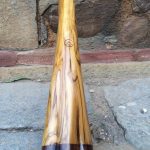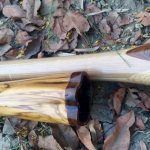A walk through the world’s oldest wind instrument with master and maker, Abhinav Deodhar and his Anandamide Didgeridoos
Much before we had the fanciest flutes and polished brass instruments, there was the didgeridoo which is believed to be the world’s oldest wind instrument. When you are in the soundscape of a didgeridoo, it is almost impossible to ignore the instrument’s impact and how it unapologetically just drags you into its trance without your permission! Although today, the didgeridoo finds its place in various genres, the circumstances around which it arose were completely different. Join me in walking through the grandeur of this instrument with master player and maker Abhinav Deodhar who has been crafting his own didgeridoos as ‘Anandamide’ and playing them all over the Himalayas and across the country.
The didgeridoo originated amongst the tribal in the northern regions of Australia. “Young 2-5 years old eucalyptus trees were eaten up by termites because the tree’s core was soft. The termites would eat the core leaving the rest. The naturally hollowed tress was picked up aboriginal people and these were the first known didgeridoos,” Abhinav explained. As each log had a distinct shape of its own there was no specific shape or size to a didgeridoo. Each didgeridoo was roughly 3 to 12ft long depending on the size of the log – this length essentially defines the key of the instrument. Longer the instrument, lower its pitch or key and vice versa. Images of this instrument float around the internet with various tribal paintings on the exterior of the instrument but traditionally, there were no paintings on the instrument. Later, for decoration purposes, each instrument was painted differently to have its own unique identity.
Talking about his first encounter with the instrument, he recalls saying, “I was trekking and had taken a complete off route than the usual trail as I wished to spend time in solitude. As I sat on a raised rock looking at sun, I started focusing on the sounds of the wind and some occasional sounds of birds, etc. Then I noticed a deep buzzing sound which did not sound like any bird. I was drawn towards the sound so much that I started following it. Soon I reached a point where I saw this man sitting with a long wooden log blowing into it. The vibrations were so strong that I got completely absorbed. I must have sat there for easily around 50 minutes and completely forgot about the trek. At first I started noticing everything that was happening, the vibrations, the way he was playing, etc. after a little when I closed my eyes, that’s when the vibrations and impact of the instrument hit me! I came back longing for a didgeridoo. Unfortunately, it was not available in musical shops. So I started looking for it on the internet and figured it was available in a shop in Paharganj. Next day I went to check it out. They only had plastic copies and not a real didgeridoo. There was a hippie guy looking for a Veena in the shop. I soon realized that he had a huge fabric bag as if either he was carrying a riffle or a didgeridoo. Somehow a conversation happened and Orlan (the hippie) agreed to sell me his Agave didgeridoo in exchange of a Veena.”
“Traditional didgeridoos are made from various types of wood which add different nuances to the overall sound of the instrument. However, today there are a few different ways to make a didgeridoo as once cannot get naturally hollowed didges everywhere like before. Some makers drill a hole in a log, some split in into 2 and hollow it and then paste it back. These days people are making didgeridoos out of fibre glass, metal, agave, clay, hemp etc. as well,” he continued.
The technique used to play this instrument is often mistaken as just “blowing into the log” while there is a complete science to this. Many people who have seen musicians play the didgeridoos have wondered how the player can constantly keep the drone going without breathing! Circular breathing as how it’s called is a special technique used where the didgeridoo is played with continuously vibrating lips to produce the drone while breathing. “It is basically breathing in through the nose whilst simultaneously expelling stored air out of the mouth using the tongue and cheeks. Once mastered, how long a player plays the didgeridoo doesn’t matter because this technique of breathing becomes a natural,” said Abhinav.
Completely engulfed by the sound and depth of the instrument, Abhinav started crafting his own didgeridoos and called them ‘Anandamide’ or what is commonly known as the bliss molecule. “For me that was the apt name for the feeling I got from the sound and the vibrations. Anandamide Didgeridoo is a small effort/boutique to craft highly resonant wind instruments with love and passion. I craft didgeridoos from different kinds of seasoned hardwoods like different Indian teak woods, rose wood, ash, eucalyptus, steam beech, etc. I also craft lighter travelling didgeridoos from agave. My latest has been making a sliding wooden didgeridoos for professional players as these slide didgeridoos have a range of 12-8 keys in a single instrument. It’s like having twelve different didgeridoos in one. It gives freedom to the player to match the drone to the correct pitch if they are playing with other musicians. In fact, I am one of the only two artists in the world to craft a double sliding wooden didgeridoo made completely of wood,” he laughs it off!
The didgeridoo in contemporary times is used for a variety of purposes besides being used as a musical instrument. The infamous “didgeridoo therapy sessions” in the west is best known for helping people cope with snoring, obstructive sleep apnea, strengthening the core and upper airway muscles. These therapies are known to cure or relieve various joint, muscular and skeletal related pains as well as promote accelerated healing in various forms of bone trauma. Many say that the didgeridoo is also used in “chakra healing” which helps people in releasing energetic and emotional stagnation in their chakras (Sanskrit word which means wheel like zones of energy in the body). It is also believed that eucalyptus wood didgeridoos are also an excellent cure for smokers who are trying to quit smoking. “Sounds can have a huge impact on the state of any being. Have you noticed how people behave differently while listening to different kinds of music? You will be a certain way if you are listening to Indian Classical Music, a certain way when you listen to heavy metal, etc. It’s the vibrations that affect our body and different kinds of vibrations have huge effects on us.”














